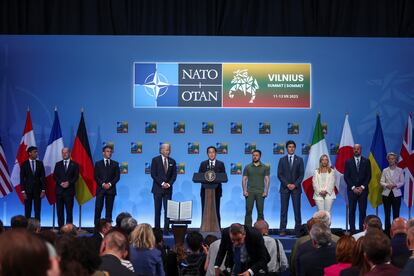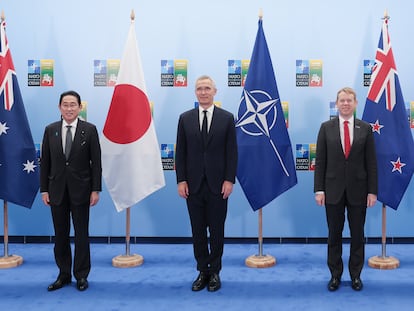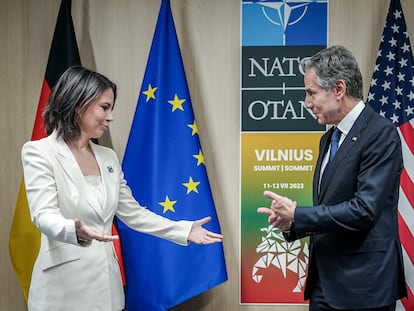With NATO focused on Ukraine war, threats from the south take a back seat
The Alliance has launched a study to assess potential risks from North Africa, the Sahel and Middle East, but the area was left out of regional plans approved at Vilnius summit

NATO faces a formidable set of threats on its eastern flank. The large-scale invasion of Ukraine by Russian forces has sparked a far-reaching military and geopolitical confrontation. Further along the eastern axis, China continues to rise, causing concern among the Atlantic allies, which are strengthening ties with Pacific democracies that share the same concern. Given the magnitude of these problems, the issue of the southern flank, of greatest interest to countries such as Spain, Italy and Portugal, finds it difficult to establish itself as a priority in the Alliance and attract attention.
The final communiqué from the Vilnius summit mentions the southern flank, a broad, somewhat indefinite geographical, strategic and military concept that encompasses North Africa, the Sahel region between the Sahara desert and the savanna, and the Middle East. The allies have asked the North Atlantic Council, the Alliance’s main political decision-making body, to launch a broad reflection on existing and emerging threats in the region, as well as opportunities for interaction with countries, international organizations or other relevant actors. The mandate requires presenting the work at the next NATO summit, scheduled for next year in Washington.
The statement points to the explosive mix of institutional fragility, climate change and the proliferation of terrorist organizations in the region, and denounces actions by Russia to fuel tensions and instability there. The strong presence in the region of the Russian Wagner organization is a source of renewed concern after the notorious rebellion led by its mercenaries.
“The southern flank is not as high a priority for NATO as the east. There has been a line of work open on it, however, since the Brussels summit in 2021, largely thanks to Spain,” says Luis Simón, director of the office of the Elcano Royal Institute think tank in Brussels. “The United States has supported keeping this issue alive, to have it brought up again at the Washington summit next year.”
“The focus on the east is inevitable given the war in Ukraine and the prospect of a long-running confrontation with Russia,” says Ian Lesser, vice president of the German Marshall Fund. “But there is a recognition of the need to deal with risks from other sides. The Vilnius summit has blessed an elaborate set of regional defense plans, one of which is geared toward the Mediterranean and Black Sea. There is also a focus on anti-terrorism. And the prospect of closer cooperation between the EU and NATO will have practical implications, especially looking to the south.”
The matter, then, remains on the table. The difficulty lies in getting it to transcend to higher levels of organization and structure.
Regarding the regional plans, according to Simón, the three areas covered are the northern zone — which encompasses the Arctic, Finland, the connection with the Atlantic, Sweden as soon as it joins NATO, another area that covers the central corridor — which essentially covers Poland and the Baltics — and another southern area that in fact means the south of the eastern flank, so Romania, Bulgaria and the eastern Mediterranean.
Therefore, there is no special attention paid to the entire segment of the western southern flank, which covers the Sahel, the central-western part of North Africa and the corresponding maritime zone.
“These schemes are important,” Simón stresses, “because they are concrete; they will guide the allocation of forces, training, capacity development, even industrial planning, based on the needs set out in the plans. And there the south is left a little by itself.”
On the other hand, although it is true that NATO insists on a risk-preparedness approach that is not only based on geography, but also on concepts, with terrorism figuring prominently, Simón points out that it involves “less precise planning than the territorial one.”
The path to achieving a qualitative leap on this flank is, therefore, complicated. Besides Spain’s efforts, Italy’s prime minister, Giorgia Meloni, recently said that “Italy supports the evolution of NATO and the attention that must be paid to the eastern flank, but we have also called for more attention to the southern flank.” And António Costa, Prime Minister of Portugal, expressed satisfaction at the study scheduled to be analyzed at the next summit.
Sign up for our weekly newsletter to get more English-language news coverage from EL PAÍS USA Edition
Tu suscripción se está usando en otro dispositivo
¿Quieres añadir otro usuario a tu suscripción?
Si continúas leyendo en este dispositivo, no se podrá leer en el otro.
FlechaTu suscripción se está usando en otro dispositivo y solo puedes acceder a EL PAÍS desde un dispositivo a la vez.
Si quieres compartir tu cuenta, cambia tu suscripción a la modalidad Premium, así podrás añadir otro usuario. Cada uno accederá con su propia cuenta de email, lo que os permitirá personalizar vuestra experiencia en EL PAÍS.
¿Tienes una suscripción de empresa? Accede aquí para contratar más cuentas.
En el caso de no saber quién está usando tu cuenta, te recomendamos cambiar tu contraseña aquí.
Si decides continuar compartiendo tu cuenta, este mensaje se mostrará en tu dispositivo y en el de la otra persona que está usando tu cuenta de forma indefinida, afectando a tu experiencia de lectura. Puedes consultar aquí los términos y condiciones de la suscripción digital.
More information
Archived In
Últimas noticias
Most viewed
- Reinhard Genzel, Nobel laureate in physics: ‘One-minute videos will never give you the truth’
- Oona Chaplin: ‘I told James Cameron that I was living in a treehouse and starting a permaculture project with a friend’
- Pablo Escobar’s hippos: A serious environmental problem, 40 years on
- Why we lost the habit of sleeping in two segments and how that changed our sense of time
- Charles Dubouloz, mountaineering star, retires at 36 with a farewell tour inspired by Walter Bonatti










































